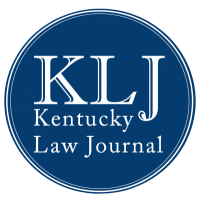Blog Post | 108 KY. L. J. ONLINE | Mar. 5, 2020
From 1973 to Today: The Risks of Funding Public Education by the Property Tax
By Morgan King[1]
The property tax has been a source of revenue for governments since the days of feudal England.[2] Following the American Revolution, the new government levied a property tax to be used for the local benefit of those owning property.[3] In modern America, school districts rely on the local property tax to fund public school education.[4]
The revenue from property is received from the land and improvements to land, which generates a tax “equal to the percentage of taxable value of the property.”[5] It follows that not all property, and further, jurisdictions, are taxed uniformly. A neighborhood with many businesses generates higher property taxes than empty lots in a rural area. Thus, a jurisdiction with lower home values generates less property taxes than any wealthier neighboring jurisdictions. Despite the inequality, schools in these jurisdictions are left to educate students uniformly, yet that education can vary dependent solely upon the resources available.[6]
In 2016, NPR presented a report on the variation of school funding across the United States.[7] The data found that, across the country, students “in the same grade attending schools” are educated “with wildly different resources.”[8] In Kentucky, the data shows variation across the state, with the majority of the state falling at or below the national average of school district spending per student.[9] In Northern Kentucky, for example, the disparity of funding per student compared to its southern county neighbors is particularly disproportionate.[10]
Property taxes affecting education inequality is not a novel idea. In the 1973 Supreme Court case San Antonio Independent School District v. Rodriguez, a group of plaintiffs brought a claim against the constitutionality of funding public schools.[11] The disparity between two school districts in San Antonio was the basis of the complaint, comparing one poor, school district in San Antonio against its more affluent neighboring school district.[12] Upon the idea that “education is perhaps the most important function of state and local governments” and “must be made available to all on equal terms” that Brown v. Board of Education held,[13] the plaintiffs made their case that using property taxes to fund school districts inherently keeps lower-income communities from attaining the same education as those with school districts funded by higher property values.[14] The Supreme Court held against the plaintiffs. In the opinion, Justice Powell reasoned that because the plaintiffs were not outright denied an education because of their economic status, the government could not intervene under a strict scrutiny standard.[15]
Therefore, the inequality of school funding remained. In order to alleviate the disparity, some states have instead imposed a limit on the property tax rate for local school districts, making up the difference in revenue with increases in other taxes and providing an oversight role for the state.[16] Michigan, for example, was successful with this reform, one report noting improved levels of academic achievement by this method.[17]
The NPR Report highlighted that education inequality based upon funding is as much as an issue today as it was in 1973. When considering what an equal and rewarding education for every student represents, states should take note at how geographic location and tax plays a role.
[1] Staff Editor, Ky. L. J., Vol. 108.
[2] Alana Semuels, The Feudal Origins of America’s Most-Hated Tax, Atlantic (Aug. 24, 2016), https://www.theatlantic.com/business/archive/2016/08/the-feudal-history-of-property-tax-in-america/497099/.
[3] Id.
[4] Cory Turner et al., Why America's Schools Have a Money Problem, NPR (Apr. 18, 2016, 5:00 AM), https://www.npr.org/2016/04/18/474256366/why-americas-schools-have-a-money-problem.
[5] How do State and Local Property Taxes Work?, Tax Pol’y Center, https://www.taxpolicycenter.org/briefing-book/how-do-state-and-local-property-taxes-work.
[6] Alana Semuels, Good School, Rich School; Bad School, Poor School, Atlantic (Aug. 25, 2016), https://www.theatlantic.com/business/archive/2016/08/property-taxes-and-unequal-schools/497333/.
[7] Turner et al., supra note 4.
[8] Id.
[9] Id.
[10] Id.
[11] San Antonio Indep. Sch. Dist. v. Rodriguez, 411 U.S. 1 (1973).
[12] Jeffrey S. Sutton, San Antonio Independent School District v. Rodriguez and its Aftermath, 94 Va. L. R. 1963 (2008); see also Turner et al., supranote 4.
[13] Sutton, supra note 12, at 1963 (quoting Brown v. Bd. of Educ., 347 U.S. 483, 493 (1954)).
[14] Rodriguez, 411 U.S. at 1.
[15] Sutton, supra note 12, at 1969.
[16] Frequently Asked Questions on the Property Tax, Nat’l Conf. St. Legis., https://www.ncsl.org/research/education/funding-approaches-the-property-tax-and-public-ed.aspx.
[17] Joydeep Roy, Impact of School Finance Reform on Resource Equalization and Academic Performance: Evidence from Michigan, 6 Educ. Fin. Pol’y 137, 138 (Spring 2011).

